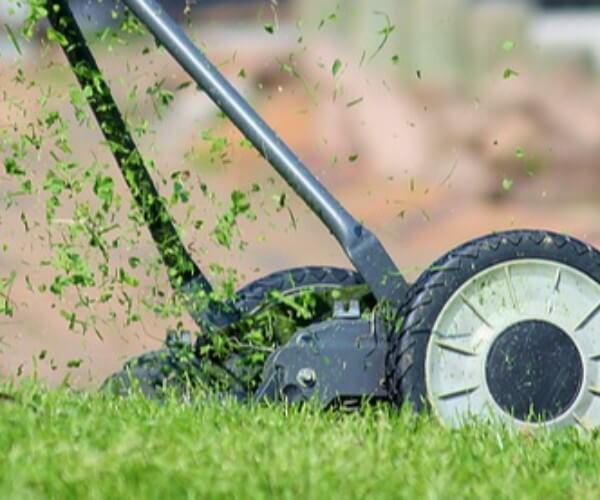- Turf
- Artificial
- Soil
- Timber
- Composite Decking
- Paving & Stone
Get In Touch With Our Experts Today!
Give us a Call! - Seed & Fertiliser
- Dressing
- Bark

March 03, 2021 Turf Tips
March is a big month for gardeners and landscapers, as it’s officially the start of spring! Evenings become a little lighter, the sun shines a bit brighter, and we feel like we can finally get outside and take care of our lawns.
But March can still hold the occasional cold snap and frosty mornings, influencing how you tend to your turf. In this article, we’ll highlight the key turf tasks to take up in March that will help your lawn recover from winter and prepare for spring. Encouraging a healthy, vibrant lawn ready for use.
As the last traces of winter melt away, March is the perfect time to assess your lawn’s condition and prepare it for the growing months ahead. The colder months can take a toll on turf, leaving it weak, patchy, or stressed. By identifying the issues early and taking the proper steps, you can restore its health and help produce a lush, green lawn that’ll thrive throughout the warmer months.
Winter can leave several types of damage on your lawn, including:
Once you’ve identified turf winter damage, here are some practical ways to repair your lawn:
Once you’ve identified and resolved any post-winter issues, you can start preparing your lawn for spring. Here are our top turf tips for March:
With warmer weather, giving your lawn its first cut of the year can be very beneficial. If the weather is still wet or frozen, wait another week or so. The height of your mower blade is very important, as we don’t want to stress your grass right from the start! For the first cut, set your mower to its highest height and be sure not to cut more than a quarter of the total height of your lawn.
You only really want to cut the tops of your grass. This will stimulate growth while the grass produces heavy green leaves that aid the photosynthesis process. If you cut your lawn too short, you will put your grass under unnecessary stress, hindering your lawn’s health in the long run.
When your lawn has been left to its own devices throughout winter, naturally, its edges might look a bit dishevelled. Not to worry. A quick cut around the edges of your lawn will help define its shape, deliver a neat finish and make it look aesthetically pleasing.
You may not need to use a fertiliser on your lawn, but if your grass looks tired, patchy, thin, or discoloured, it will give your grass the boost it needs. Nitrogen and potassium are the key nutrients that aid growth. So, look for a spring fertiliser rich in both. Be mindful to check the weather forecast, as spring showers could wash fertiliser away before it is absorbed.
March is an ideal month to begin scarifying your lawn. This is the process of removing organic matter from around the stem of the grass blades to maintain a healthy growing environment above and below the surface. By removing dead grass blades, debris and lawn clippings, you can keep your lawn in excellent health.
Don’t worry too much about weeds. They’re most likely still dormant from winter, and temperatures remain too low for herbicides or weed killers to work effectively. If you spot any weeds, take note and be ready to suppress them next month.
Winter often leads to the build-up of organic matter, fallen debris and rotting leaves. All of these can cause issues to your lawn and drainage if not handled correctly. Make sure the edges of your lawn are clear so excess water can easily run off. If your drainage has a slope, make sure it’s clear of piles of debris preventing water from draining away and resulting in water pooling on the surface of your lawn and damaging your turf.
Have you noticed yellowish grass spots that make your lawn look like it’s dying or turning brown? This could be a fungus known as fusarium. Lawn fungus issues can escalate quickly post-winter, with patches increasing in size — some surpassing 30cm in diameter! If you’re experiencing these issues, apply a fungicide to control the effects of the disease. In doing so, you will help your grass fight off fusarium naturally whilst improving your soil’s health and drainage. For more insight, head to our Guide to Lawn Fungus and Diseases.
Absolutely! March is a brilliant time to lay turf. If it’s been raining, the ground should be softer, making it easier to remove existing turf. March also offers preferable temperatures and plenty of rainfall, making turf laying much simpler. It’ll also give your turf a good few weeks to settle in and establish strong roots ready for the growing season.
By tackling winter damage and preparing your lawn with proper care in March, you’ll set the stage for a healthy, thriving turf throughout the warmer months. A little early-season effort goes a long way in achieving a lush, green lawn that will be the envy of the neighbourhood! If you need any further tips, check out our blog library or get in touch with the team.
If you’re a landscaper, check out our George Davies Trade Account. We’re here to ensure you have access to premium products and reliable deliveries so you can provide first-class service to your customers.
How to Reseed a Lawn in Spring